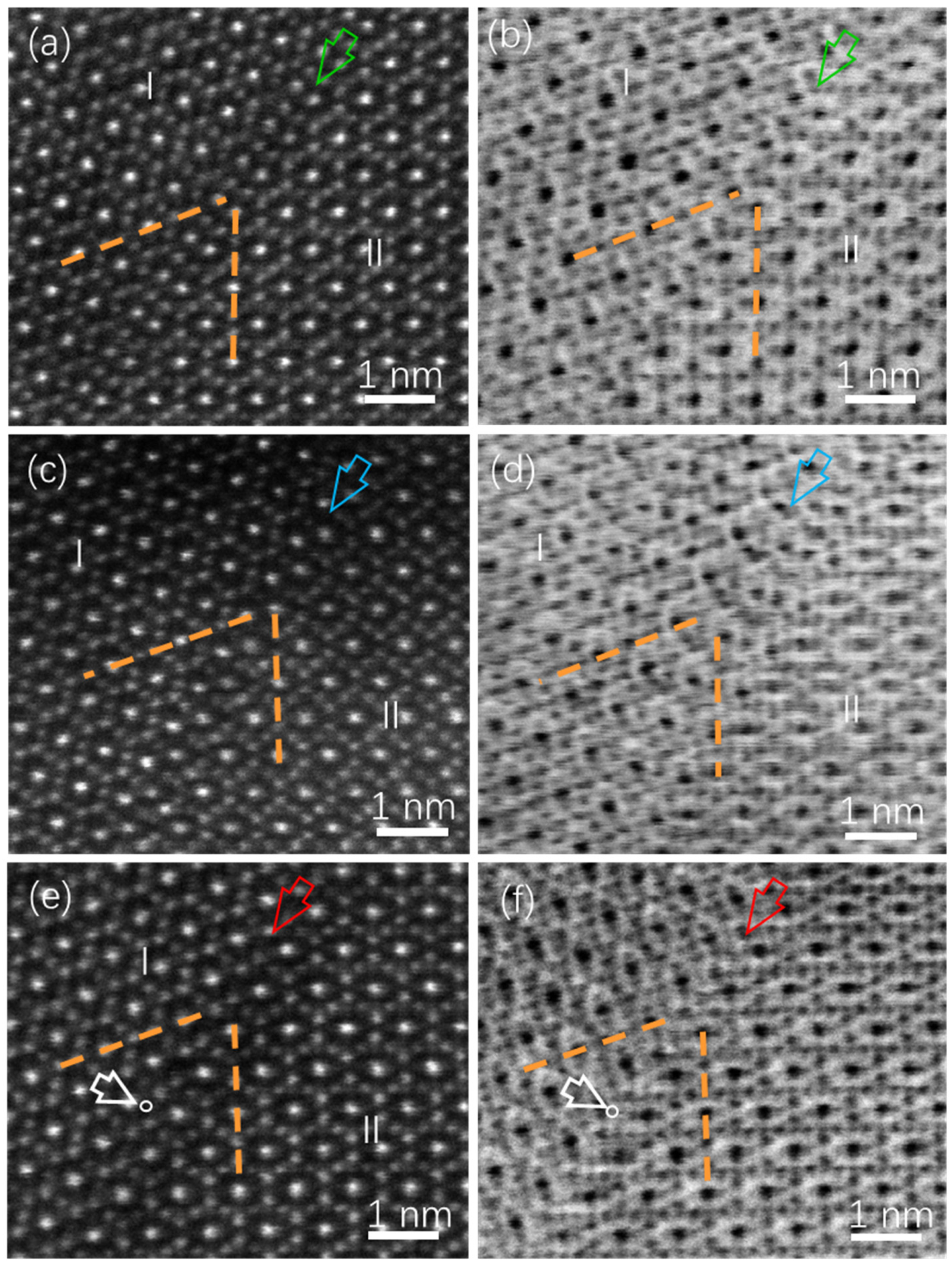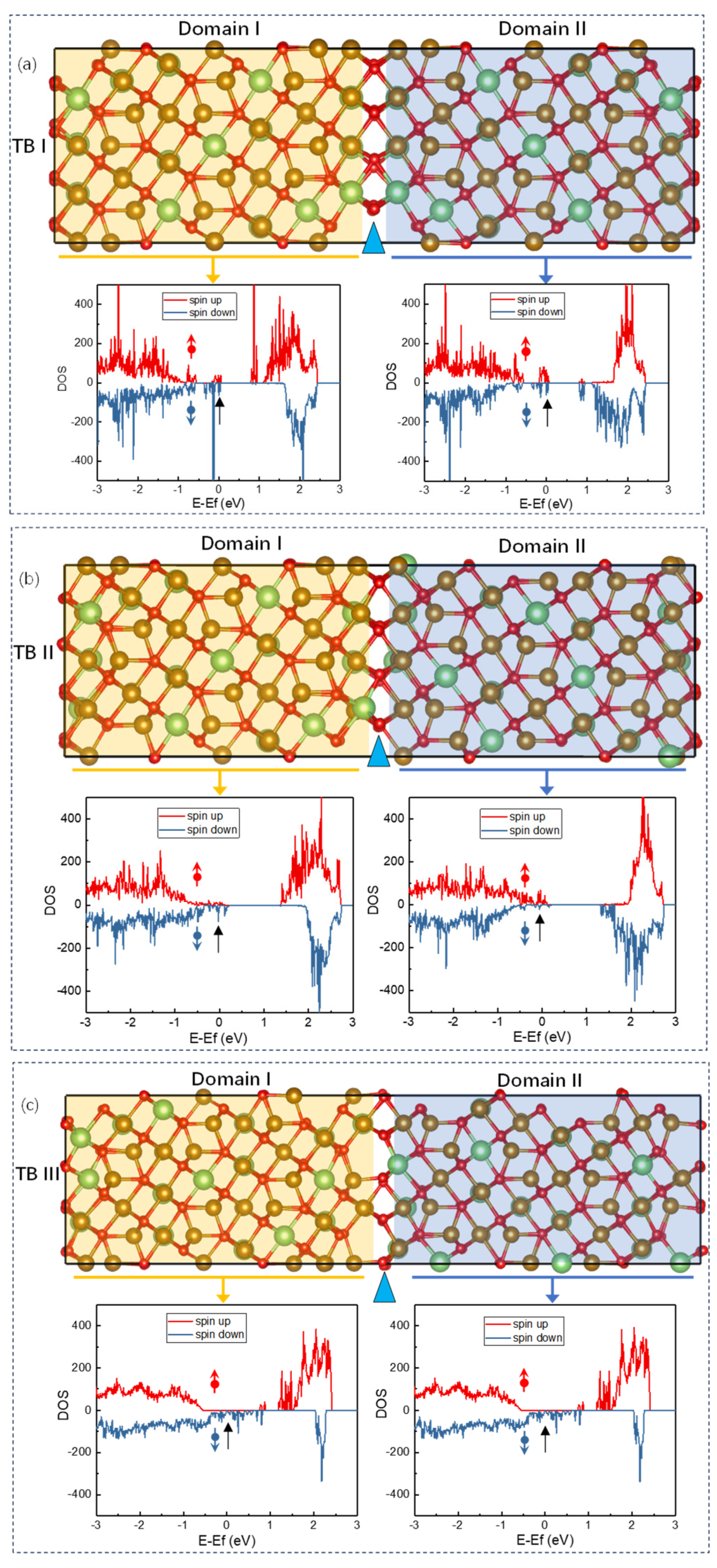Atomic-Scale Structural and Magnetic Coupling Properties of Twin Boundaries in Lithium Ferrite (Li0.5Fe2.5O4) Film
Abstract
:1. Introduction
2. Materials and Methods
3. Results and Discussions
4. Conclusions
Supplementary Materials
Author Contributions
Funding
Institutional Review Board Statement
Informed Consent Statement
Data Availability Statement
Conflicts of Interest
References
- Sanchez-Lievanos, K.R.; Stair, J.L.; Knowles, K.E. Cation Distribution in Spinel Ferrite Nanocrystals: Characterization, Impact on their Physical Properties, and Opportunities for Synthetic Control. Inorg. Chem. 2021, 60, 4291–4305. [Google Scholar] [CrossRef]
- McKenna, K.P.; Hofer, F.; Gilks, D.; Lazarov, V.K.; Chen, C.; Wang, Z.; Ikuhara, Y. Atomic-scale Structure and Properties of Highly Stable Antiphase Boundary Defects in Fe3O4. Nat. Commun. 2014, 5, 5740. [Google Scholar] [CrossRef] [PubMed]
- Mi, S.B.; Zhang, R.Y.; Lu, L.; Liu, M.; Wang, H.; Jia, C.L. Atomic-scale Structure and Formation of Antiphase Boundaries in α-Li0.5Fe2.5O4 Thin Films on MgAl2O4(001) Substrates. Acta Mater. 2017, 127, 178–184. [Google Scholar] [CrossRef]
- Singh, A.V.; Khodadadi, B.; Mohammadi, J.B.; Keshavarz, S.; Mewes, T.; Negi, D.S.; Datta, R.; Galazka, Z.; Uecker, R.; Gupta, A. Bulk Single Crystal-Like Structural and Magnetic Characteristics of Epitaxial Spinel Ferrite Thin Films with Elimination of Antiphase Boundaries. Adv. Mater. 2017, 29, 1701222. [Google Scholar] [CrossRef] [PubMed]
- Liu, X.; Wu, M.; Qu, K.; Gao, P.; Mi, W. Atomic-Scale Mechanism of Grain Boundary Effects on the Magnetic and Transport Properties of Fe3O4 Bicrystal Films. ACS Appl. Mater. Interfaces 2021, 13, 6889–6896. [Google Scholar] [CrossRef] [PubMed]
- Li, Z.; Lu, J.; Jin, L.; Rusz, J.; Kocevski, V.; Yanagihara, H.; Kita, E.; Mayer, J.; Dunin-Borkowski, R.E.; Xiang, H.; et al. Atomic Structure and Electron Magnetic Circular Dichroism of Individual Rock Salt Structure Antiphase Boundaries in Spinel Ferrites. Adv. Funct. Mater. 2021, 31, 2008306. [Google Scholar] [CrossRef]
- Gao, C.; Jiang, Y.; Yao, T.; Tao, A.; Yan, X.; Li, X.; Chen, C.; Ma, X.-L.; Ye, H. Atomic Origin of Magnetic Coupling of Antiphase Boundaries in Magnetite Thin films. J. Mater. Sci. Technol. 2022, 107, 92–99. [Google Scholar] [CrossRef]
- Margulies, D.T.; Parker, F.T.; Rudee, M.L.; Spada, F.E.; Chapman, J.N.; Aitchison, P.R.; Berkowitz, A.E. Origin of the Anomalous Magnetic Behavior in Single Crystal Fe3O4 Films. Phys. Rev. Lett. 1997, 79, 5162. [Google Scholar] [CrossRef]
- Xu, K.; Lin, T.; Rao, Y.; Wang, Z.; Yang, Q.; Zhang, H.; Zhu, J. Direct Investigation of the Atomic Structure and Decreased Magnetism of Antiphase Boundaries in Garnet. Nat. Commun. 2022, 13, 3206. [Google Scholar] [CrossRef]
- Wu, H.C.; Abid, M.; Chun, B.S.; Ramos, R.; Mryasov, O.N.; Shvets, I.V. Probing One Antiferromagnetic Antiphase Boundary and Single Magnetite Domain Using Nanogap Contacts. Nano Lett. 2010, 10, 1132–1136. [Google Scholar] [CrossRef]
- Xu, K.; Hung, S.-W.; Si, W.; Wu, Y.; Huo, C.; Yu, P.; Zhong, X.; Zhu, J. Topotactically Transformable Antiphase Boundaries with Enhanced Ionic Conductivity. Nat. Commun. 2023, 14, 7382. [Google Scholar] [CrossRef] [PubMed]
- Leung, G.W.; Vickers, M.E.; Yu, R.; Blamire, M.G. Epitaxial Growth of Fe3O4 (111) on SrTiO3 (001) Substrates. J. Cryst. Growth 2008, 310, 5282–5286. [Google Scholar] [CrossRef]
- Lee, D.; Trang, T.T.T.; Heo, Y.-U. Role of Dislocation Climb on Twin Boundary and Antiphase Boundary Formations in Inverse-Spinel MnAl2O4. J. Alloy Compd. 2023, 958, 170526. [Google Scholar] [CrossRef]
- Guo, Z.; Jiang, H.; Sun, X.; Li, X.; Liu, Z.; Zhang, J.; Luo, J.; Zhang, J.; Tao, X.S.; Ding, J.; et al. Ultrafast Non-Equilibrium Phase Transition Induced Twin Boundaries of Spinel Lithium Manganate. Adv. Energy Mater. 2024, 14, 2302484. [Google Scholar] [CrossRef]
- Chen, C.; Li, H.; Seki, T.; Yin, D.; Sanchez-Santolino, G.; Inoue, K.; Shibata, N.; Ikuhara, Y. Direct Determination of Atomic Structure and Magnetic Coupling of Magnetite Twin Boundaries. ACS Nano 2018, 12, 2662–2668. [Google Scholar] [CrossRef] [PubMed]
- Liu, K.; Zhang, R.; Lu, L.; Mi, S.; Liu, M.; Wang, H.; Wu, S.; Jia, C. Atomic-scale Investigation of Spinel LiFe5O8 Thin Films on SrTiO3 (001) Substrates. J. Mater. Sci. Technol. 2020, 40, 31–38. [Google Scholar] [CrossRef]
- Dehghani Dastjerdi, O.; Shokrollahi, H.; Mirshekari, S. A Review of Synthesis, Characterization, and Magnetic Properties of Soft Spinel Ferrites. Inorg. Chem. Commun. 2023, 153, 110797. [Google Scholar] [CrossRef]
- Kim, S.Y.; Kim, K.S.; Jong, U.G.; Kang, C.J.; Ri, S.C.; Yu, C.J. First-principles Study on Structural, Electronic, Magnetic and Thermodynamic Properties of Lithium Ferrite LiFe5O8. RSC Adv. 2022, 12, 15973–15979. [Google Scholar] [CrossRef] [PubMed]
- Zhang, R.; Liu, M.; Lu, L.; Mi, S.-B.; Wang, H. Strain-tunable Magnetic Properties of Epitaxial Lithium Ferrite Thin Film on MgAl2O4 Substrates. J. Mater. Chem. C 2015, 3, 5598–5602. [Google Scholar] [CrossRef]
- Madsen, J.; Susi, T. The abTEM code: Transmission Electron Microscopy from First Principles. Open Res. Eur. 2021, 1, 24. [Google Scholar] [CrossRef]
- Kresse, G.; Joubert, D. From Ultrasoft Pseudopotentials to the Projector Augmented-wave Method. Phys. Rev. B 1999, 59, 1758–1775. [Google Scholar] [CrossRef]
- Perdew, J.P.; Burke, K.; Ernzerhof, M. Generalized Gradient Approximation Made Simple. Phys. Rev. Lett. 1996, 77, 3865–3868. [Google Scholar] [CrossRef] [PubMed]
- Chadi, D.J. Special Points for Brillouin-zone Integrations. Phys. Rev. B 1977, 16, 1746–1747. [Google Scholar] [CrossRef]
- Anisimov, V.I.; Zaanen, J.; Andersen, O.K. Band Theory and Mott insulators: Hubbard U instead of Stoner I. Phys. Rev. B 1991, 44, 943. [Google Scholar] [CrossRef] [PubMed]
- Howard, S.A.; Yau, J.K.; Anderson, H.U. Structural Characteristics of Sr1−xLaxTi3+δ as a Function of Oxygen Partial Pressure at 1400 °C. J. Appl. Phys. 1989, 65, 1492–1498. [Google Scholar] [CrossRef]
- Pennycook, S.J.; Boatner, L.A. Chemically Sensitive Structure-imaging with a Scanning Transmission Electron microscope. Nature 1988, 336, 565–567. [Google Scholar] [CrossRef]
- Desai, H.B.; Tanna, A.R. Effect of Substitution on the Electric and Magnetic Properties of Ferrites. In Ferrites and Multiferroics: Engineering Materials; Bhargava, G.K., Bhardwaj, S., Singh, M., Batoo, K.M., Eds.; Springer: Singapore, 2021. [Google Scholar]
- Liu, K.; Zhang, R.; Lu, L.; Li, J.; Zhang, S. Effect of Film Thickness on Microstructural and Magnetic Properties of Lithium Ferrite Films Prepared on Strontium Titanate (001) Substrates. Coatings 2023, 13, 2097. [Google Scholar] [CrossRef]
- Vronka, M.; Straka, L.; Graef, M.D.; Heczko, O. Antiphase Boundaries, Magnetic Domains, and Magnetic Vortices in Ni–Mn–Ga Single Crystals. Acta Mater. 2020, 184, 179–186. [Google Scholar] [CrossRef]




| Type of TBs | Formation Energy (J/m2) | Exchange Coupling Energy (EFM-EAFM) (J/m2) | Magnetic Coupling |
|---|---|---|---|
| TB I | 1.67 | 0.39 | AFM |
| TB II | 0.75 | 0.47 | AFM |
| TB III | 2.80 | −0.06 | FM |
Disclaimer/Publisher’s Note: The statements, opinions and data contained in all publications are solely those of the individual author(s) and contributor(s) and not of MDPI and/or the editor(s). MDPI and/or the editor(s) disclaim responsibility for any injury to people or property resulting from any ideas, methods, instructions or products referred to in the content. |
© 2024 by the authors. Licensee MDPI, Basel, Switzerland. This article is an open access article distributed under the terms and conditions of the Creative Commons Attribution (CC BY) license (https://creativecommons.org/licenses/by/4.0/).
Share and Cite
Liu, K.; Li, J.; Zhang, S. Atomic-Scale Structural and Magnetic Coupling Properties of Twin Boundaries in Lithium Ferrite (Li0.5Fe2.5O4) Film. Coatings 2024, 14, 903. https://doi.org/10.3390/coatings14070903
Liu K, Li J, Zhang S. Atomic-Scale Structural and Magnetic Coupling Properties of Twin Boundaries in Lithium Ferrite (Li0.5Fe2.5O4) Film. Coatings. 2024; 14(7):903. https://doi.org/10.3390/coatings14070903
Chicago/Turabian StyleLiu, Kun, Jiankang Li, and Songyou Zhang. 2024. "Atomic-Scale Structural and Magnetic Coupling Properties of Twin Boundaries in Lithium Ferrite (Li0.5Fe2.5O4) Film" Coatings 14, no. 7: 903. https://doi.org/10.3390/coatings14070903





